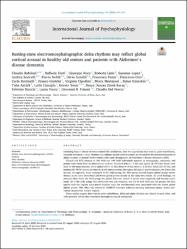Resting-state electroencephalographic delta rhythms may reflect global cortical arousal in healthy old seniors and patients with Alzheimer's disease dementia

View/
Access
info:eu-repo/semantics/embargoedAccessDate
2020Author
Babiloni, ClaudioFerri, Raffaele
Noce, Giuseppe
Lizio, Roberta
Lopez, Susanna
Soricelli, Andrea
Nobili, Flavio
Arnaldi, Dario
Fama, Francesco
Orzi, Francesco
Buttinelli, Carla
Giubilei, Franco
Cipollini, Virginia
Marizzoni, Moira
Güntekin, Bahar
Aktürk, Tuba
Hanoğlu, Lütfü
Yener, Görsev
Emek Savaş, Derya Durusu
Stocchi, Fabrizio
Vacca, Laura
Frisoni, Giovanni B.
Del Percio, Claudio
Metadata
Show full item recordCitation
Babiloni, C., Ferri, R., Noce, G., Lizio, R., Lopez, S., Soricelli, A. ... Del Percio, C. (2020). Resting-state electroencephalographic delta rhythms may reflect global cortical arousal in healthy old seniors and patients with Alzheimer's disease dementia. International Journal of Psychophysiology, 158, 259-270. https://dx.doi.org/10.1016/j.ijpsycho.2020.08.012Abstract
Extending Basar's theory of event-related EEG oscillations, here we hypothesize that even in quiet wakefulness, transient increases in delta rhythms may enhance global cortical arousal as revealed by the desynchronization of alpha rhythms in normal (Nold) seniors with some derangement in Alzheimer's disease dementia (ADD).Clinical and EEG datasets in 100 ADD and 100 Nold individuals matched as demography, education, and gender were taken from an international archive. Standard delta (< 4 Hz) and alpha1 (8-10.5 Hz) bands were used for the main analysis, while alpha2 (10.5-13 Hz), theta (4-8 Hz), beta1 (13-20 Hz), beta2 (20-35 Hz), and gamma (35-40 Hz) served as controls. In the interpretation, the higher the alpha1 power (density), the lower that arousal. As expected, when compared to the Nold group, the ADD group showed higher global (scalp) power density at the delta-theta band and lower global power density at the alpha-beta bands. As novel findings, we observed that: (1) in the Nold group, the global delta and alpha1-2 power were negatively and linearly correlated; (2) in the ADD group, this correlation was just marginal; and (3) in both Nold and AD groups, the EEG epochs with the highest delta power (median value for stratification) were associated with the lowest global alpha1 power. This effect was related to eLORETA freeware solutions showing maximum alpha1 source activations in posterior cortical regions.These results suggest that even in quiet wakefulness, delta and alpha rhythms are related to each other, and ADD partially affects this cross-band neurophysiological mechanism.
WoS Q Kategorisi
Q2xmlui.dri2xhtml.METS-1.0.item-scopusquality
Q2Source
International Journal of PsychophysiologyVolume
158Collections
- Makale Koleksiyonu [301]
- Makale Koleksiyonu [3777]
- PubMed İndeksli Yayınlar Koleksiyonu [4230]
- Scopus İndeksli Yayınlar Koleksiyonu [6574]
- WoS İndeksli Yayınlar Koleksiyonu [6631]

















